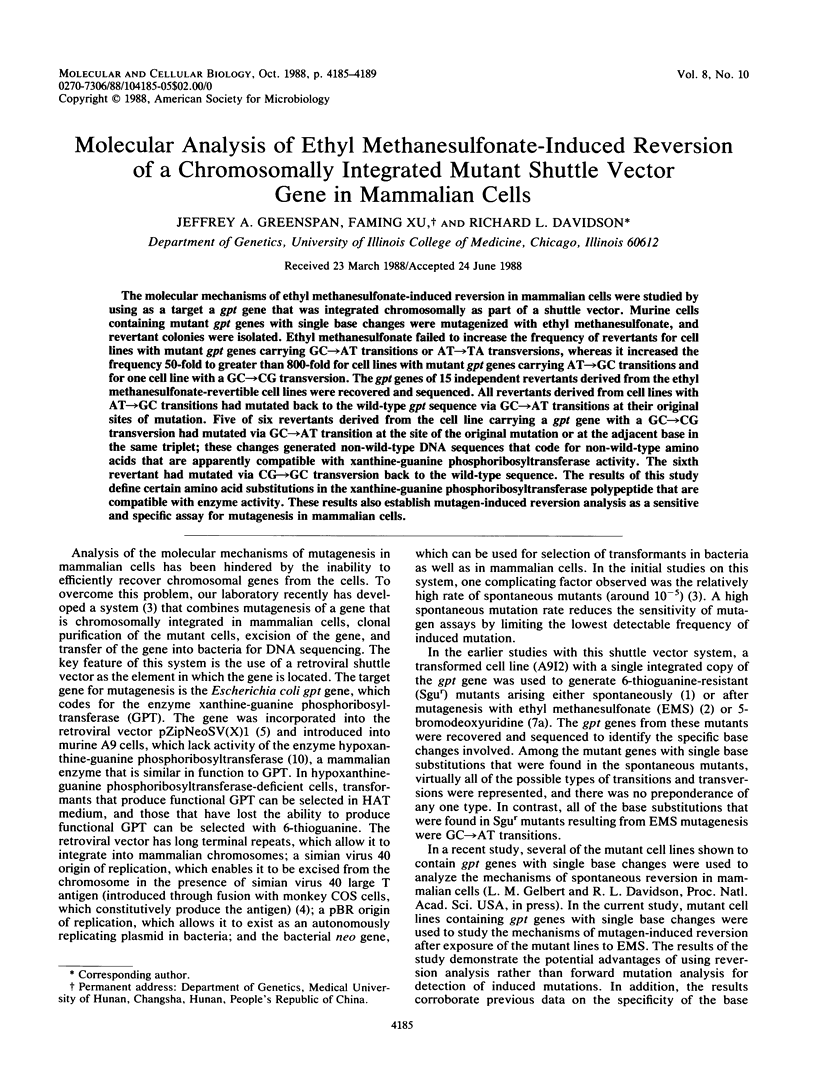Abstract
The molecular mechanisms of ethyl methanesulfonate-induced reversion in mammalian cells were studied by using as a target a gpt gene that was integrated chromosomally as part of a shuttle vector. Murine cells containing mutant gpt genes with single base changes were mutagenized with ethyl methanesulfonate, and revertant colonies were isolated. Ethyl methanesulfonate failed to increase the frequency of revertants for cell lines with mutant gpt genes carrying GC----AT transitions or AT----TA transversions, whereas it increased the frequency 50-fold to greater than 800-fold for cell lines with mutant gpt genes carrying AT----GC transitions and for one cell line with a GC----CG transversion. The gpt genes of 15 independent revertants derived from the ethyl methanesulfonate-revertible cell lines were recovered and sequenced. All revertants derived from cell lines with AT----GC transitions had mutated back to the wild-type gpt sequence via GC----AT transitions at their original sites of mutation. Five of six revertants derived from the cell line carrying a gpt gene with a GC----CG transversion had mutated via GC----AT transition at the site of the original mutation or at the adjacent base in the same triplet; these changes generated non-wild-type DNA sequences that code for non-wild-type amino acids that are apparently compatible with xanthine-guanine phosphoribosyltransferase activity. The sixth revertant had mutated via CG----GC transversion back to the wild-type sequence. The results of this study define certain amino acid substitutions in the xanthine-guanine phosphoribosyltransferase polypeptide that are compatible with enzyme activity. These results also establish mutagen-induced reversion analysis as a sensitive and specific assay for mutagenesis in mammalian cells.
Full text
PDF




Selected References
These references are in PubMed. This may not be the complete list of references from this article.
- Ashman C. R., Davidson R. L. DNA base sequence changes induced by ethyl methanesulfonate in a chromosomally integrated shuttle vector gene in mouse cells. Somat Cell Mol Genet. 1987 Sep;13(5):563–568. doi: 10.1007/BF01534497. [DOI] [PubMed] [Google Scholar]
- Ashman C. R., Davidson R. L. Sequence analysis of spontaneous mutations in a shuttle vector gene integrated into mammalian chromosomal DNA. Proc Natl Acad Sci U S A. 1987 May;84(10):3354–3358. doi: 10.1073/pnas.84.10.3354. [DOI] [PMC free article] [PubMed] [Google Scholar]
- Ashman C. R., Jagadeeswaran P., Davidson R. L. Efficient recovery and sequencing of mutant genes from mammalian chromosomal DNA. Proc Natl Acad Sci U S A. 1986 May;83(10):3356–3360. doi: 10.1073/pnas.83.10.3356. [DOI] [PMC free article] [PubMed] [Google Scholar]
- Breitman M. L., Tsui L. C., Buchwald M., Siminovitch L. Introduction and recovery of a selectable bacterial gene from the genome of mammalian cells. Mol Cell Biol. 1982 Aug;2(8):966–976. doi: 10.1128/mcb.2.8.966. [DOI] [PMC free article] [PubMed] [Google Scholar]
- Cepko C. L., Roberts B. E., Mulligan R. C. Construction and applications of a highly transmissible murine retrovirus shuttle vector. Cell. 1984 Jul;37(3):1053–1062. doi: 10.1016/0092-8674(84)90440-9. [DOI] [PubMed] [Google Scholar]
- Chasin L. A., Urlaub G. Mutant alleles for hypoxanthine phosphoriboxyltransferase: codominant expression, complementation, and segregation in hybrid Chinese hamster cells. Somatic Cell Genet. 1976 Sep;2(5):453–467. doi: 10.1007/BF01542725. [DOI] [PubMed] [Google Scholar]
- Coulondre C., Miller J. H. Genetic studies of the lac repressor. IV. Mutagenic specificity in the lacI gene of Escherichia coli. J Mol Biol. 1977 Dec 15;117(3):577–606. doi: 10.1016/0022-2836(77)90059-6. [DOI] [PubMed] [Google Scholar]
- Davidson R. L., Broeker P., Ashman C. R. DNA base sequence changes and sequence specificity of bromodeoxyuridine-induced mutations in mammalian cells. Proc Natl Acad Sci U S A. 1988 Jun;85(12):4406–4410. doi: 10.1073/pnas.85.12.4406. [DOI] [PMC free article] [PubMed] [Google Scholar]
- DuBridge R. B., Tang P., Hsia H. C., Leong P. M., Miller J. H., Calos M. P. Analysis of mutation in human cells by using an Epstein-Barr virus shuttle system. Mol Cell Biol. 1987 Jan;7(1):379–387. doi: 10.1128/mcb.7.1.379. [DOI] [PMC free article] [PubMed] [Google Scholar]
- LITTLEFIELD J. W. THREE DEGREES OF GUANYLIC ACID--INOSINIC ACID PYROPHOSPHORYLASE DEFICIENCY IN MOUSE FIBROBLASTS. Nature. 1964 Sep 12;203:1142–1144. doi: 10.1038/2031142a0. [DOI] [PubMed] [Google Scholar]
- Lebkowski J. S., Miller J. H., Calos M. P. Determination of DNA sequence changes induced by ethyl methanesulfonate in human cells, using a shuttle vector system. Mol Cell Biol. 1986 May;6(5):1838–1842. doi: 10.1128/mcb.6.5.1838. [DOI] [PMC free article] [PubMed] [Google Scholar]
- Mulligan R. C., Berg P. Expression of a bacterial gene in mammalian cells. Science. 1980 Sep 19;209(4463):1422–1427. doi: 10.1126/science.6251549. [DOI] [PubMed] [Google Scholar]
- Prakash L., Stewart J. W., Sherman F. Specific induction of transitions and transversions of G-C base pairs by 4-nitroquinoline-1-oxide in iso-1-cytochrome c mutants of yeast. J Mol Biol. 1974 May 5;85(1):51–65. doi: 10.1016/0022-2836(74)90128-4. [DOI] [PubMed] [Google Scholar]
- Richardson K. K., Richardson F. C., Crosby R. M., Swenberg J. A., Skopek T. R. DNA base changes and alkylation following in vivo exposure of Escherichia coli to N-methyl-N-nitrosourea or N-ethyl-N-nitrosourea. Proc Natl Acad Sci U S A. 1987 Jan;84(2):344–348. doi: 10.1073/pnas.84.2.344. [DOI] [PMC free article] [PubMed] [Google Scholar]


